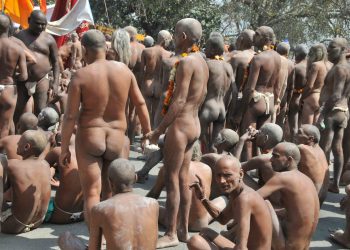
Chinnamasta is a form of Hindu Goddess Shakti. She is one of the ten Mahavidyas or Wisdom Goddesses. Chinna means severed and masta means head. This means one whose head is severed. She is depicted as decapitating her own head and holding it in her hand and a scimitar in the other. Three streams of blood spurting out of the neck, consumed by the two attendants and by the goddess herself. The goddess and her two attendants symbolically represents the three nadis or the psychic channels in the body – Sushumna, Ida and Pingala. She is adorned with garlands of skulls and necklaces of bones. She wears a snake as a sacred thread.
Chinnamasta or Chinnamastika or PrachandaChandika, the Goddess with the severed head, is perhaps the most horrible and disturbing representation of the Great Divine Mother. There are many myths associated with her but she has come to prominence mainly as Mahavidya. Chinnamasta self-destructs to support and promote life in its various forms: the life represented by the couple who makes love under her, the death she reveals in decapitating herself and the nourishment that manifests herself in nourishing the yoginis are all integral aspects of life.
The explanations of the symbolisms associated with the horrible image of Chinnamasta are truly numerous, being regarded as the classic imaginary of tantric symbolism. Chinnamasta, in her creative and destructive aspects, means apparent dissolution and return to the elements. She embodies heroism (Vira); she demonstrates the rare courage needed to make the highest imaginable sacrifice. The cut head represents the non-mind (Unmana) or the state freed from the limitations of the mind.
Chinnamasta awakens consciousness. It is the conscious beyond the Mind. The severed head means discarding the ego and all identities on the path of spiritual awakening, an indispensable factor for achieving liberation. She represents the free flow of energy through the Sushumna channel. She is the Kundalini Shakti that flows upward from the base of the spine to blow up in Sahasrara Chakra and unite with infinity. She is also seen as a symbol of self-control, fearlessness and the incarnation of sexual energy.
- To remove obstacles in the path of success.
- To defeat enemies.
- For awakening the Kundalini Shakti.
- To get control over sexual desires.

Pieter Weltevrede – is a Master “Sacred-Artist” based out of the Netherlands. After a many years of guidance, under his guru Late Harish Johari a successful author, a gifted painter and sculptor, a lifetime scholar, an inspiring teacher, a splendid cook, an ayurvedic massage miracle, etc., Pieter embarked on his own journey amalgamating ancient Indian knowledge with his own western sensibilities evolving an art form that appeals to todays international audience. He has been practising his art form from the last 40 years now. His original paintings are in water colours on silk with a wash-technique that gives them a very three-dimensional feel. The complexity and detail in his works are a super-human endeavour as he continues to live a mundane life travelling between the Western World and India.
Here, ‘Saraswati Yantra’ paintings are printed on coated matt paper by inkjet printer, using ultra chrome inks with an off-white paper mounting with golden border, and encased inside a fibre frame with acrylic sheet cover in the front.
Click Here to visit our Shop Site.









